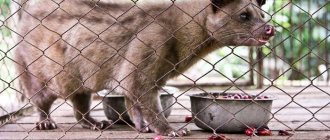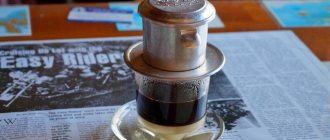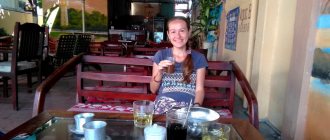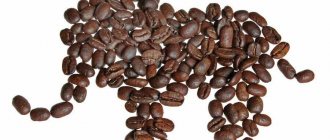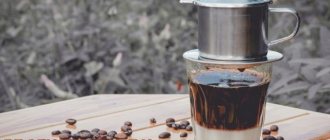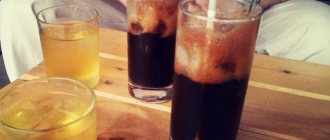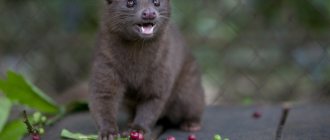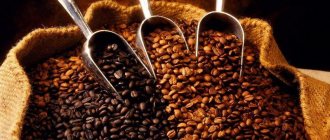Description of musangs
A small and nimble predatory mammal belonging to the Viverridae family, it has a very characteristic appearance . In their appearance, musangs vaguely resemble a ferret and a cat. Since 2009, the issue of adding several endemics to the territory of Sri Lanka to the three existing species of musang has been considered.
Appearance
The average body length of an adult musang is about 48-59 cm, with a total tail length of 44-54 cm. The weight of a mature predatory animal varies from 1.5-2.5 to 3.8-4.0 kg. Musangs have a very flexible and elongated body on short but strong legs, which have the usual retractable claws, like those of any cat. The animal is distinguished by a wide head with a narrow muzzle and a large wet nose, very large bulging eyes, as well as fairly widely spaced and rounded ears of medium size. The teeth are short, rounded, and the molars have a pronounced square shape.
This is interesting! Thanks to the presence of special scent glands, Malayan palm civets received their unusual nickname - hermaphrodites (hermaphroditus).
The paws and muzzle, as well as the ears of this wild animal, are noticeably darker than the color of the body. There may be whitish spots in the muzzle area. The coat of the animal is quite hard and thick, in grayish tones. The fur is represented by a soft undercoat and a tougher outer coat.
Character and lifestyle
Musangs are typical nocturnal animals . During the daytime, such small animals try to sit comfortably on tangles of vines, among tree branches, or quite easily and quickly climb into squirrel holes, where they go to sleep. Only after sunset do they begin active hunting and searching for food. At this time, Malayan palm martens very often make shrill and extremely unpleasant sounds. Thanks to the presence of claws and the structure of the limbs, musangs are able to move very well and quickly through trees, where such a mammalian predator spends a significant part of its free time. If necessary, the animal runs neatly and quickly enough on the ground.
This is interesting! Due to the small number of currently existing representatives of the species, as well as their nocturnal lifestyle, the behavioral characteristics of the Sri Lankan musang are poorly studied.
Sometimes Malayan palm civets settle on the roofs of residential buildings or stables, where they scare residents at night with loud noise and characteristic screams. However, the small and incredibly active predator brings enormous benefits to humans, destroying very large numbers of rats and mice, as well as preventing epidemics spread by these rodents. Palm martens lead a preferentially solitary lifestyle, so this predatory mammal unites in pairs exclusively during the mating season for reproduction.
How long does a musang live?
The average, officially registered life expectancy of a musang in the wild is between 12-15 years, and a domestic predatory animal can easily live up to twenty years, but domesticated individuals are known whose age was almost a quarter of a century.
Sexual dimorphism
Females and males of the musang have special glands resembling testicles, which secrete a special odorous secretion with a characteristic musky odor. As such, pronounced morphological differences between males and females of the same species are completely absent. Females have three pairs of nipples.
Return to content
Description and features of musang
The musang or palm civet is a small carnivorous animal from the civet family. This family is the most numerous among all predators.
The common musang lives in South and Southeast Asia, it can be found in Indonesia - on the island of Bali, in China, in Sri Lanka, on the islands of the Philippines, Sumatra and Java. They are also kept in captivity on farms in Vietnam.
This charming animal is so beloved by Asians that it is kept in homes as a pet - like in our country, for example, a ferret or a cat. He gets used to people very well and becomes not only an affectionate and good-natured pet, but also an excellent hunter, protecting the yard from the invasion of rats and mice.
Pictured is musang
The appearance of the musang in the photo somewhat resembles both a cat and a ferret at the same time. The animal's coat is short, thick and dense, and feels hard to the touch. The most common color is gray-brown interspersed with black.
The back is decorated with longitudinal black stripes, and on the sides there are black specks. Musang has a characteristic “mask”: a narrow muzzle, the fur around the eyes and ears is dark, almost black, and the forehead is usually light. The animal's eyes are slightly protruding, its ears are small and round.
The body of this animal is dense, very flexible, dexterous and agile. It is small in height - the size of a small cat. The elongated body together with the tail reaches a length of about one meter; weight indicators can range from 2 to 4 kilograms.
The Musang animal has two characteristic features: the first is that the animal, like a cat, has claws that retract inside the paw pads. And the second is that individuals of both sexes have special glands that resemble testicles, which secrete an odorous secretion with the smell of musk.
Musang animals endlessly adore coffee berries, for which they have received their special position and fame throughout the world. In ancient times, about two centuries ago, Indonesia was a colony of the Netherlands.
Then local farmers were prohibited from collecting coffee from the colonialists' plantations. To somehow get out of the situation, the natives looked for grains that had fallen to the ground.
A little later it turned out that these were not just grains, but waste from the musanga palm marten - that is, feces. Some people quickly realized that the taste of such a drink is in many ways tastier and more aromatic than regular coffee.
The photo shows musang excrement containing coffee beans.
Since then, the animals have been actively involved in the process of producing a charming drink, which is known as “Kopi-Luwak” - translated from the local dialect, “Kopi” means “coffee”, and “Luwak” is the name of this unusual animal.
The main value in the production process of this coffee is the special composition of enzymes in the digestive system of animals, thanks to which the magical process of transformation of simple coffee beans occurs.
They break down substances that give the drink additional bitterness, they change their taste and aroma, and acquire pleasant shades of honey and nougat. Once the digested grains are collected, they are washed and cleaned, then dried and roasted. After which the unusual coffee can be considered ready for drinking.
Musanga coffee is one of the rarest and most expensive varieties. After all, finding these beans in the wild, in the jungle, is quite difficult - and this is the product that is valued above all else: animal gourmets choose the best, ripest coffee berries, which in appearance resemble ripe cherries. An interesting fact is that animals prefer Arabica to all other types of coffee.
The price of musang coffee, which is bred in captivity on farms - for example, in Vietnam - is significantly lower In addition, grains are often simply flavored with civet, a substance secreted by animals.
Types of musangs
The main difference between representatives of different types of mustangs is the difference in the color of their coat:
- The Asian Musang has a gray coat with black stripes along the entire body. Only closer to the abdominal area do such stripes lighten and gradually turn into spots;
- The Sri Lankan Musang is a rare species with a coat ranging from dark brown to light brownish-red and bright gold to reddish-gold. There are also individuals with a fairly faded light brown coat color;
- South Indian Musang - distinguished by a solid brown color, with darkening of the fur around the neck, head, tail and paws. Sometimes there is gray hair on the coat. The color of this animal is extremely diverse, ranging from pale beige or light brown to dark brown shades. The dark tail sometimes has a pale yellow or pure white tip.
This is interesting! Musangs have the largest number of subspecies among the representatives of the Viverridae family, including Ph hermaphroditus, Ph bondar, Ph canus, Ph dongfangensis, Ph exitus, Ph kangeanus, Ph lignicolor, Ph minor, Ph nictitans, Ph pallasii, Ph parvus, Ph pugnax, Ph pulcher, Ph scindiae, Ph setosus, Ph simplex and Ph vellerosus.
Brown representatives have similar patterns, having a brownish color, and the golden musang has a predominant golden brown color with iridescent hair tips.
Return to content
Range, habitats
Malayan palm civets or Malayan palm civets have become quite widespread in South and Southeast Asia. The Musang's habitat is represented by India, southern China, Sri Lanka, Hainan Island and the Southern Philippines, as well as Borneo, Sumatra, Java and numerous other islands. The natural habitat of the predatory animal is tropical forest zones.
The South Indian musang or brown strangetail is an inhabitant of subtropics and tropical forests, which are located at an altitude of 500-1300 meters above sea level. Often such animals are found near tea plantations and human habitation. Sri Lankan musangs prefer the most humid habitats, including evergreen mountain, tropical and monsoon forest zones, living mainly in the crowns of the largest trees.
Return to content
Musang's lifestyle and habitat
Musangs inhabit not only tropical rainforests - they can also be found near people, in parks and farmland, and can inhabit the attic of a private house, barn or sewer pipe.
Musang is a nocturnal animal, like many of its family. During the day, he sleeps and hides in forks and on tree branches or in hollows. At night, he begins a period of activity and food production.
Civets are excellent at climbing trees - for them this is their native element and the main place of hunting. They always live alone, do not live in groups and do not form pairs.
These animals are very well tamed and friendly to humans, however, if you decide to buy a musang , remember that in any case it is a wild animal with all its own characteristics and behavior.
Pictured are baby musangs
He will be awake at night and asleep during the day, and will certainly make a lot of noise. He needs enough space to climb, run and be active a lot - which means you need to take care to provide him with a comfortable home where he won’t ruin anything or cause mayhem.
In general, it is worth thinking and weighing everything carefully many times. to buy a Musang animal from breeders who professionally breed them.
Musang diet
The main, predominant part of the diet of Sri Lankan musangs is represented by all kinds of fruits . Predatory animals with great pleasure eat quite a large number of mangoes, coffee, pineapples, melons and bananas. Occasionally, palm martens also eat various small vertebrates, including not too large birds and snakes, as well as lizards and frogs, bats and worms. The diet of adult musangs also includes a wide variety of insects and fermented palm sap called toddy, which is why locals often call such animals toddy cats. Occasionally, animals settling near human habitation steal all kinds of poultry.
Classified as omnivores, mussangs consume a wide variety of food types, but have become famous for consuming grain from coffee plantations. Such undigested grains make it possible to obtain the most delicious and most expensive type of coffee, Kopi Luwak. When eating coffee fruits, the animals excrete them in almost undigested, pure form. However, under the influence of natural enzymes, some processes take place in the intestinal tract of the musang that significantly improve the quality characteristics of coffee beans.
Return to content
Nutrition
The basis of the musang's diet is plant food - in addition to coffee berries, the animals adore ripe fruits and some plants. But at the same time, they are not at all averse to destroying a nest and gobbling up bird eggs, they can catch small birds, and feast on small rodents, lizards, insects and their larvae.
In captivity, animals will happily feast on fruits and vegetables, fresh dairy products, low-fat meat, eggs and grains.
Reproduction and offspring
Musangs reach sexual maturity at approximately one year of age. A sexually mature female mustang approaches the male only during the period of active mating. After a couple of months, not too many offspring are born in a pre-arranged and prepared hollow. As a rule, babies are born between early October and mid-December. Female Sri Lankan musangs can have two litters during the year.
Most often, in one musanga litter, from two to five blind and completely defenseless cubs are born, with a maximum weight of about 70-80 grams. On the eleventh day, the babies' eyes open, but they continue to feed on the female's milk until they are two months old.
The female protects and feeds her offspring until the age of one year, after which the grown and strengthened animals become completely independent.
Return to content
Musang: the animal with the most expensive feces in the world
Human food preferences are quite diverse, and gourmets eat a lot of things: from creepy insects to live fish. But to feast on poop of your own free will, and even for fabulous money, is truly an amazing thing! But this is not fiction at all, but a fact. Meet the Musang or Malayan Palm Civet. It is its waste products that bring coffee fans into ecstasy. And we'll tell you why.
Source: yandex.ru
First, let's get to know the animal better. The length of its body from nose to tip of tail can reach 120 cm. Outwardly, it is very similar to a hybrid of a cat and a ferret.
Source: yandex.ru
Source: yandex.ru
The same elongated muzzle, small teeth, a long body crowned with a rather large tail and paws with sharp claws that can be hidden in the pads as unnecessary.
The color of the fur depends on the habitat. Musangs are most often found in South and Southeast Asia and have a gray skin color, diluted with black stripes.
Source: yandex.ru
The animals run very quickly and climb trees. The main activity occurs at night. During the day, they prefer to rest peacefully in hollows or in convenient forks of branches.
Source: yandex.ru
Representatives of the species are characterized by complete loneliness; only during the mating season are they ready to tolerate an individual of the opposite sex with them. By the way, for a long time it was believed that all civets are hermaphrodites. The source of the misjudgment was the fact that females and males have certain baggy appendages very similar to testicles.
Source: yandex.ru
But it soon became clear that they were not intended to determine gender at all, but to mark territory with the help of special glands.
Source: yandex.ru
Animals absolutely adore the fruits of the coffee tree, but for lack of anything better, they may well snack on insects or small birds. The mother feeds only her cubs, which are born two months after mating, exclusively with milk for a whole year.
Source: yandex.ru
What is so remarkable about animal feces? It's all about diet.
Source: yandex.ru
If coffee fruits get into the stomach of a musang, then under the influence of gastrointestinal juice their outer shell dissolves, exposing the beans and relieving them of bitterness.
Source: yandex.ru
It is not known who first came up with the idea of tasting this excrement with grain, but the fact remains that this is how the most expensive type of coffee in the world, Kopi Luwak, was born.
Source: yandex.ru
Its cost per kilogram varies at $700. Today there are even special farms that specifically breed musangs for their precious grains. True, real gourmets note that wild Kopi Luwak is much deeper and more interesting in taste.
Source: yandex.ru
This is due to the fact that under natural conditions, animals choose only the ripest and most delicious coffee berries. But on a farm they don’t have this opportunity; they have to eat what they give.
Well, be that as it may, a poop farm is much more humane than a fur farm. Animals can live there for 25 years if they are well maintained.
1111
Natural enemies
People traditionally hunt the Sri Lankan musang for its beautiful skin and delicious, quite nutritious, tasty meat . Also, in alternative medicine, the healing internal fat of Asian musangs, infused with a certain amount of well-refined flaxseed oil, is widely used.
This is interesting! In recent years, the popularity of musangs as pets has sharply increased, which are actively caught in the wild and quickly tamed, becoming affectionate and good-natured, like ordinary cats.
This composition is very ancient and, according to many doctors, a highly effective cure for complex forms of scabies. In addition, civet extracted from musangs is actively used not only in medicine, but also in the perfume industry. The animals are often destroyed as animals that harm coffee and pineapple plantations, as well as poultry yards.
Return to content
Video about musangs
Return to content
Tags: paradoxurus hermaphroditus, Asian musang, habitat, appearance, wild animals, musang, common musang, nutrition, population, natural enemies, reproduction, diet, Sri Lankan musang, South Indian musang
